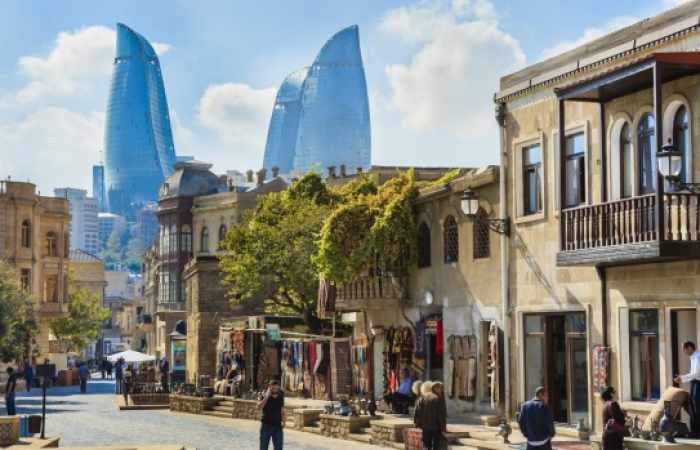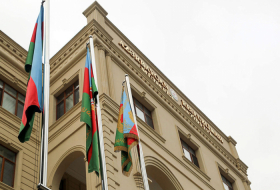About a year ago, I was on the sofa, absorbed by an early heat of Britain's Got Talent. A one-eyed man had finished balancing buckets on his head and a feeble dance-troupe was pirouetting with shopping trolleys when I received a text: "You watching Eurovision?" Another followed: "Azerbaijan are cleaning up!"
Before long, flurry became stream and forced a reluctant change of channel. The Azeri power-balladeers El and Nikki were air-grabbing their way to victory, crushing the competition beneath their impractical yet glamorous white shoes. Twitter was simultaneously triumphant and confused: "Where is Azerbaijan?" it demanded. A few years ago, I was commissioned to write a guide to Baku and – honestly – I started with the same question.
Azerbaijan wasn't always a backwater. Indeed, a century-and-a-half ago it was very much in the mainstream. Oil-soaked earth had long been used as a fuel in Azerbaijan, but it was the drilling of the first commercial oil well in 1846 that led to a massive influx of opportunists. For a time Baku was to oil what Klondike was to gold – the Rothschilds and Nobels were among those who found wealth there. A new city, conceived in the grand European style, sprang up around the sleepy, walled old city of Baku – now a Unesco-listed world heritage site. Opulent palaces, opera houses and theatres were built to bring culture to the city's newly prosperous inhabitants. Then came the First World War and, in its confused aftermath, the Soviet invasion. Seventy-odd years of occupation did an excellent job of wiping Baku's name from the world's collective consciousness.
Baku's regeneration has been flamboyant. The city has thrown up more glitz and glass than the opening credits of Dallas. Pricey restaurants and showy "VIP" (pronounced "Veep") clubs have opened, the gaudy trappings of a city keen to attract those with cash. Wait till you see Eurovision's glittering home at the new Crystal Hall. It's proper bling. Indeed, the programme of renovation has been so glossy (and glassy) that the casual observer will see little evidence of the city's dusty, desert roots.
For years, a brace of Hyatts stood as Baku's sole "international" hotels. Then came its first boutique hotel, the Sultan Inn. Now, no fewer than five new international hotel brands are opening properties of predictably lofty proportions. The most architecturally dramatic is the Fairmont, occupying one of the three vast Flame Towers, which loom large on a ridge overlooking Baku bay. The design of the towers is said to echo Azerbaijan's long cultural attachment to fire. (The name Azerbaijan is said by some to derive from the old Persian Atropatene, meaning, loosely, "Land of Fire", a region that was also the birthplace of the fire-worshipping Zoroastrians.)
The towers have polarised opinion locally and internationally – they're a unique and impressive shape certainly; a little reminiscent of the British Gas logo. Down by the seafront, the first Four Seasons in the former Soviet Union occupies a newly built palace in the grand old euro-Azeri (pastiche) style. The crumbling monoliths of the Absheron and Azerbaijan hotels are both now long gone. In their place, flanking the hulking yet handsome Soviet edifice of Government House, have risen the smoky-mirrored towers of the J W Marriott (adjacent to the ultra-high-end Emporium fashion store, where daughters of the elite throw money at handbags) and the frankly hideous Hilton. Finally, there's the marginally more understated Kempinski, just behind Flame Towers, somewhat removed from the downtown bustle.
Locally, the smartest beach-front place is reckoned to be the new Jumeirah resort at Bilgah, which has a central spinnaker motif shamelessly aping the Burj Al Arab hotel in Dubai, albeit painted red. Proof, were proof needed, that Baku aspires to be the Dubai of the Caucasus.

When it comes to eating out, things are no less evolved. Around four years ago, a new restaurant, Zakura, introduced Nobu-inspired Japanese fusion to Azeri palates. Then, from the same management, came Chinar, an establishment that offered a broader pan-Asian repertoire. The same company's newest opening is the ambitious Sahil development on the waterfront, with Italian, South American and upmarket Azeri kitchens and a fantastic view over the Caspian Sea. Indeed, modern Azeri seems to have replaced sushi as Baku's cuisine du moment, with the newcomers Zeytun, Sumakh and the Art Garden joining the old stalwarts, the Mugam Club and the Old City Restaurant, in a contest to be the best purveyor of national food. In my experience, the Old City just takes the culinary crown, while the Mugham Club's atmospheric caravanserai setting (with nightly traditional mugham music and dance) wins on ambience.
Azeri viticulture is also on the up, with decent "dry" reds from the Ganja and Ismayilli regions becoming popular. While Baku's nightlife is not as evolved as, say, Moscow's, the downtown area around Fountains Square is awash with low-rent pubs aimed squarely at international oil-workers, with affordable beer, Western pub grub and pool tables. At the other end of the scale, Chinar's Dragon Club and Hezz Club pop Cristal corks for the moneyed, with Opera Lounge and the World Fashion Club snapping at their aggressively expensive heels.

Baku is a city like no other. And there is so much more than the brash and glitzy glass towers. There's the grand Boulevard, with its creaky, yet charismatic, Soviet-era fairground rides. There's the mazelike Old City, stuffed with cafés and carpet shops. The (predominantly Azeri) Modern Art Museum is impressive – more so than the world's tallest flagpole (another of Baku's idiosyncratic claims to fame). Elsewhere on the Absheron, if you can navigate a path through the spilt oil, low salinity seawater laps some surprisingly golden beaches, rigs shimmering surreally on the horizon.
The rest of this remarkable land is no less surprising. Incredibly, for a country the size of England, it has nine of the world's 11 possible climatic zones. There are significant prehistoric stone carvings; a vast new billion-dollar (reputedly) ski resort; half the world's mud volcanoes, Day-Glo pink salt lakes, burning mountain sides, flaming rivers and springs; Soviet-era sanatoria, offering some most peculiar therapies, involving, for example, languishing up to the neck in oily mud, or spending a month underground in a salt cave.
There are spectacular mountain ranges and barren, oily wastelands; palaces of intricate miniaturist frescoes and glorious stained glass; the world's first Christian church; the world's largest all-Jewish settlement outside Israel; an ancient community of animist Christians; mountain villages whose inhabitants speak dialects of a civilisation that died out a millennium ago...
Ben Illis is the co-author and photographer of Time Out Baku and the best of Azerbaijan (2012) and the author and photographer of Hg2 Baku (2010). See benillis.com.
/The Telegraph/
More about: #Azerbaijan #travel
















































